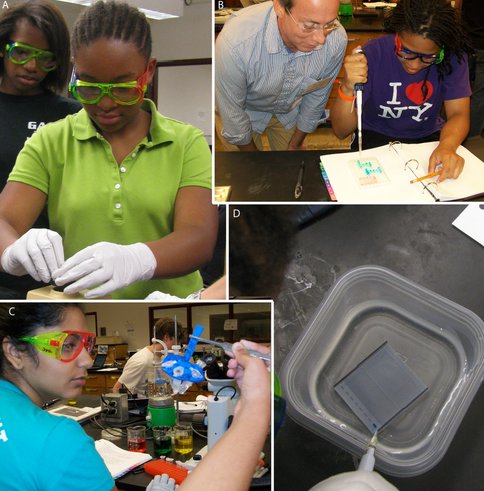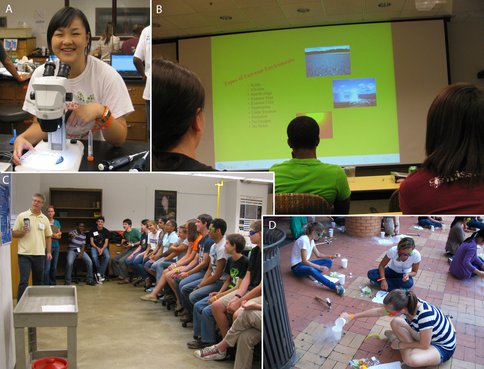2011 Annual Science Report
 Georgia Institute of Technology
Reporting | SEP 2010 – AUG 2011
Georgia Institute of Technology
Reporting | SEP 2010 – AUG 2011
Life on the Edge: Astrobiology Summer Learning Program
Project Summary
In their EPO program the Georgia Tech team leverages resources and assets including (a) CEISMC (Georgia Tech’s Center for Education Integrating Science, Mathematics, and Computing), (b) the Georgia’s GIFT program (Georgia Intern-Fellowships for Teachers), (c) the NSF-sponsored SURE program, which provides funding for undergraduates interested in teaching, (d) the NSF-sponsored Research Experiences for Undergraduates Program, (e) the Siemens-sponsored Research, Experiment, Analyze and Learn (REAL) Program, and (f) Center members laboratories and research groups. This year the Georgia Tech Team continues their week-long non-residential Summer Learning Program, called Life on the Edge: Astrobiology. The GT Team works with teachers and undergraduates, who are trained to run the camp, which is directed at high school students. Life on the Edge exposes participating teachers, undergraduates and high school students to the excitement of astrobiology, and offers teachers low cost and accessible methods and course materials for incorporating astrobiology into high school teaching programs.
Project Progress
For the third year in a row, the Georgia Tech Team ran a one-week, non-residential Summer Learning Program (SLP), called Life on the Edge: Astrobiology. This year 19 high school students, and one middle school student participated in the camp. The participants were primarily from the Atlanta metro area, but one student attended from rural Ontario. The GT Team recruited a high school Biology teacher and a middle school Life Sciences teacher into the Georgia Intern Fellowship for Teachers program (GIFT, https://www.ceismc.gatech.edu/gift). The teachers this year were from the DeKalb County School System, one of the most diverse systems in the state of Georgia serving over 100,000 students; 75% are African American, 8% Hispanic, and 66% qualify for free and reduced lunch. In an effort to promote and encourage entry into science teaching careers, the GT Team paired the teachers with two Georgia Tech undergraduate students (biology majors), through the NSF sponsored “Tech to Teaching” Program (http://nsf-i3.org/projects/view/tech_to_teaching/). The teachers and undergraduate students collaborated over the summer with GT team members to prepare and develop, conduct, document, scrutinize and analyze the SLP. They updated and improved the previous years experiments, and ensured and documented that the program is aligned with the Georgia Performance Standards in Biology. Using materials from our previous camps, the teachers and the undergraduate students prepared student and teacher guides for the 2011 Camp. They worked with GT team members, in their laboratories, to prepare the camp experiments. The teachers and undergraduate students, actually ran the camp, with participation from other GT team members.
The scientific focus of the SLP is life in extreme environments. The high school students (Figure 1) explored astrobiology, biochemistry, evolution, and molecular biology though intense, engaging, hands-on activities.
Life on the Edge: Astrobiology 2011 High school summer learning program at Georgia Tech.
Life on the Edge provides teachers, undergraduates and high school students exposure to the excitement of astrobiology, and gives the teachers methods for incorporating astrobiology into their high school teaching programs. Basic biology concepts were reviewed and explained in an astrobiological context, to illustrate the adaptation and survival of many types of extremophiles and the diversity of environments that can support life. A variety of extremophiles are grown in the SLP lab, including halophiles, psychrophiles, and thermophiles. Each student uses biological techniques such as micropipetting, gel electrophoresis, Polymerase Chain Reaction (PCR), (Figure 2) to learn the methods used by astrobiology researchers.
Life on the Edge: Activities that exposed students to lab techniques used by Astrobiologists.
Additional activities include: Desiccating and rehydrating rotifers, exploring Titan’s low temperature environment, using liquid nitrogen (Figure 3), growing extremophiles, attending lectures by the GT Center faculty, touring research labs and teaching facilities and presenting a group project in a final presentation that highlights the experimental investigation of halophiles, psychrophiles, and thermophiles.
Life on the Edge: Activities: Titan’s Temperature, dessicating rotifers, lectures, and student presentations using the presentation tool Prezi.
One of the participants from this year, Miss Sydney Jones, a 7th grader, developed a science fair project based on bacterial extremophiles and won 1st place at Rex Mill Middle School Science Fair and 1st place at the Clayton County Science Fair. She will go to the State of Georgia Science fair at the University of Georgia on March 29, 2012.
An important goal of our camp is to develop low cost/low tech astrobiology experiments and protocols that can be readily incorporated into high school laboratories, that are restrained by limited resources and expertise. The camp explicitly avoids complex and expensive equipment and experiments and develops materials that are readily accessible to high school teachers. For example we have developed an aquarium-based system for growing extremophiles (sterile techniques are not required). Following our protocols, teachers can use aquaria and bubblers (<$40) to culture thermophiles (also requires a hotplate), halophiles, alkaliphiles, acidophiles and psychrophiles (also requires an ice chest). Several of these aquaria are shown in Figure 4. In addition we have developed a PCR protocol that uses two water baths (on different two hot plates) and a stop watch. In side-by-side comparisons by the high school students, the yield of our low tech PCR method is greater than that with an expensive gradient PCR machine.
Aquaria used for growing extremophiles in a teaching laboratory.
Several evaluation techniques were used to access student learning from the Life on the Edge: Astrobiology SLP. These included pre and post data analysis and Facebook posts. The survey results reported below from the SLP indicate that the participants increased their content knowledge about DNA, extremophiles, describing rotifers and Titan’s environments, and analyzing experimental data. Specifically, students were asked to indicate how confident they felt in using, describing, and defining scientific data, methods, and tools.
Survey Questions from the Life on the Edge: Astrobiology SLP, Pre and Post camp results. Five point scale: Very Confident (5), Confident (4), Somewhat Confident, Not Confident (2), and Not at all Confident (1).
Although the survey indicates that the students increased their content knowledge at the end of the 2011 Life on the Edge: Astrobiology SLP, we also monitored social media to access student learning. During the week-long program, the students befriended each other on Facebook, talked about their experiences and continued to communicate with each other. Below are some Facebook posts by students. We found that the participants remembered what they learned and were excited that they had first hand experience with extremophiles.
- “Learning about Extremophiles in AP Bio! woo! :)”- February 8, 2012
- “Talked about Extremophiles in class!! I Was The Only One Who knew What a Halophile or a Thermophile was!! :)”- November 30, 2011
- “Stromatolites were mentioned on the PSAT!!!!!!”- October 15, 2011
- “We talked about stromatilites in AP environmental science and I got all excited knowing what they were!!!”- September 15, 2011
- “We talked about extremophiles in AP bio!! yay us:)”-September 15,2011
The Astrobiology SLP has also had a positive impact on GIFT teachers, the students they teach and Georgia Tech undergraduate students. The GIFT Program honored Mrs. Janetta Greenwood, a Biology and Applications of Biotechnology teacher at Dunwoody High School for her outstanding implementation of astrobiology lessons into the Georgia science curriculum. Ms. Greenwood’s Action Plan implementation was recognized as the First Place winner of the 2011 Paul A. Duke Action Plan Achievement Award.
Mrs. Janetta Greenwood, First Place winner of the 2011 Paul A. Duke Action Plan Achievement Award with her students, who worked in the laboratory of Dr. Eric Gaucher. L-R Dionne McKenzie, Angeline Pham, Kenny Lin, Janetta Greenwood, Kristen Ingram
She was honored with a plaque and a $1000.00 check. Working with the GT Center, Mrs. Greenwood played an integral role in designing an Astrobiology camp for high school students. Mrs. Greenwood further extended her Action Plan into a conference presentation at the 2011 Georgia Science Teachers Association (GSTA) Conference, a field trip for students to the Georgia Tech Institute for Biotechnology and the Georgia Tech Center for Advanced Brain Imaging, a website where her students submit laboratory reports, take online assessments and showcase their research, and the creation of a blog to generate dialog outside of the classroom between students in all of her classes. The Astrobiology program also fostered an interest in Biology education for two Georgia Tech students involved in the NSF funded Pre- Teaching Summer Undergraduate Research Experience Program: Mr. Peter Macaluso, former Georgia Tech Biomedical Engineering major, is now a Biology teacher at Jesuit High School in Tampa, FL. He is also responsible for beginning and advanced bands, sacred and secular choirs, string orchestra, AP music theory and guitar ensemble. Ms. Aakanksha Angra, Georgia Tech Biology major, plans to pursue a Ph.D. in Biology will a focus on Ecology and Biology Education starting in the Fall of 2012.
Mrs. Janetta Greenwood traveled to Bozeman, MT to take the Examining Life in Extreme Environments BIOL 580-03 class, which was held June 13-17, 2011 at Montana State University. This course, sponsored by the NASA Astrobiology Biogeocatalysis Research Center at MSU, allowed Mrs. Greenwood to investigate how studying the extremes of life will aid in a better understanding of early earth conditions and how scientists use this information to look for signs of life on other planets. One day of the course involved a field trip to Yellowstone National Park Environments, which gave her the opportunity to measure the pH and temperatures of extreme environments on Earth. In her 9th grade general and gifted Biology class, she now discusses extreme environments on Earth and her trip to Yellowstone as an introduction to a hands-on activity that investigates whether psychrophiles can be found in the student’s freezer at home.
-
PROJECT INVESTIGATORS:
-
PROJECT MEMBERS:
Christine Dunham
Co-Investigator
Roger Wartell
Co-Investigator
Caitlin Prickett
Research Staff
Ryan Randall
Research Staff
Aakanksha Angra
Undergraduate Student
Peter Macaluso
Undergraduate Student
Deanna Boyd
Unspecified Role
Janetta Greenwood
Unspecified Role
-
RELATED OBJECTIVES:









